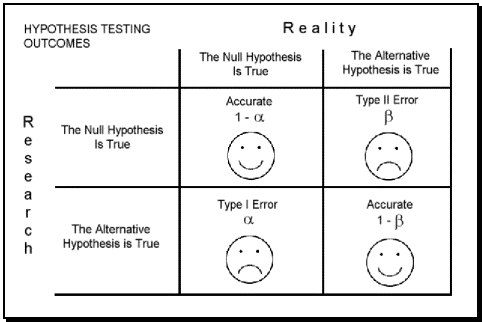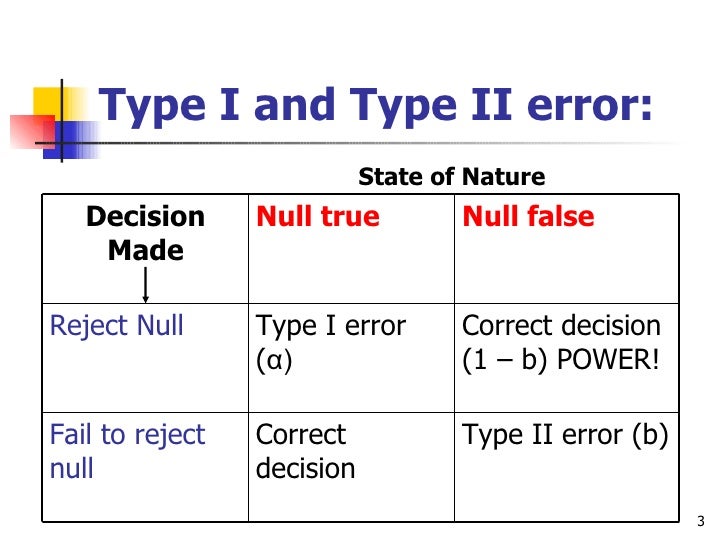
- TYPE II ERROR TRIAL
- TYPE II ERROR FREE
High quality goods are rejected by the automated inventory system. The research is accepted even if there is a difference in calculation, assuming there isn’t any. Rejection is based on a particular difference in calculation, but in reality, there is no difference. Items that are definitely dangerous may also be accepted. Items that are not dangerous may also be rejected. Possibility of acceptance even with a wrong/unauthorized match. Possibility of rejection even with an authorized match. Hackers/imposters are accepted as authorized users. Or, a drug has cured a particular disease, but is not accepted to be effective against the same.Īuthentic users may be classified as hackers. Or the notion that a particular drug has cured a disease, when in reality, the drug has had no effect on the patient.Īccepting that the person does not carry any deadly infection, in reality, he does carry a virus. Indication that a person carries a deadly virus, when in reality, he does not.
In this scenario, we fail to accept what is true. TYPE II ERROR FREE
Thus, if the statement is false, and the man is convicted, it will be the right decision, but if the man is left free despite having done the crime, a type 2 error has occurred. Similarly, let the null hypothesis ‘He is innocent’, be false in the second example, i.e., the man is actually guilty. Thus, here the null hypothesis is false, but it is being accepted. Now, this change will not be accepted by any of your guests, they would vouch that the dish is the same as before, and attribute the spicier taste to some other factor. So, let’s say, the overall consensus is that the dish will be the same as before, but since the hypothesis is false, the dish has a slightly spicier taste. In this case, you have to false null hypothesis, i.e., the statement is ‘Adding this ingredient has no effect on the dish’, when in reality, it will have some effect on the dish, good or bad. Consider the same examples as above for convenience. What ultimately happens here is that the true null hypothesis is wrongly accepted even if it is false.  It indicates the failure of being able to accept the alternative hypothesis. It is also called ‘false negative’ or ‘beta error’. In other words, it occurs when we try to ignore something that actually exists. It occurs when a null hypothesis is not rejected when it is actually false. If he is convicted for something he has not done, a type 1 error has occurred. If it is true, he will be let free, and it will be the correct decision. The null hypothesis would be a statement, like ‘He is innocent’.
It indicates the failure of being able to accept the alternative hypothesis. It is also called ‘false negative’ or ‘beta error’. In other words, it occurs when we try to ignore something that actually exists. It occurs when a null hypothesis is not rejected when it is actually false. If he is convicted for something he has not done, a type 1 error has occurred. If it is true, he will be let free, and it will be the correct decision. The null hypothesis would be a statement, like ‘He is innocent’. TYPE II ERROR TRIAL
Another example would be to consider the trial of a person accused of murder.Therefore, the null hypothesis is true in this case, but is being rejected due to false effect.Contrary to this, if your dish tastes great, it would automatically be assumed that it is so because of the extra ingredient, when in reality, it is not.

Therefore, the null hypothesis would be ‘Adding this ingredient has no effect on the taste’. In this case, the truth of taste improvement in the dish is tested.

Suppose you decide to bake lasagna, and you add an extra ingredient (assuming it will enhance the taste), that is actually not supposed to be added. So, ultimately, what happens is that the true null hypothesis is wrongly rejected even if it is true. It indicates the acceptance of the alternative hypothesis. It is also called ‘false positive’ or ‘alpha error’. In other words, it occurs when we try to find out something that does not possibly exist at all. It occurs when a null hypothesis is rejected when it is actually true.







 0 kommentar(er)
0 kommentar(er)
